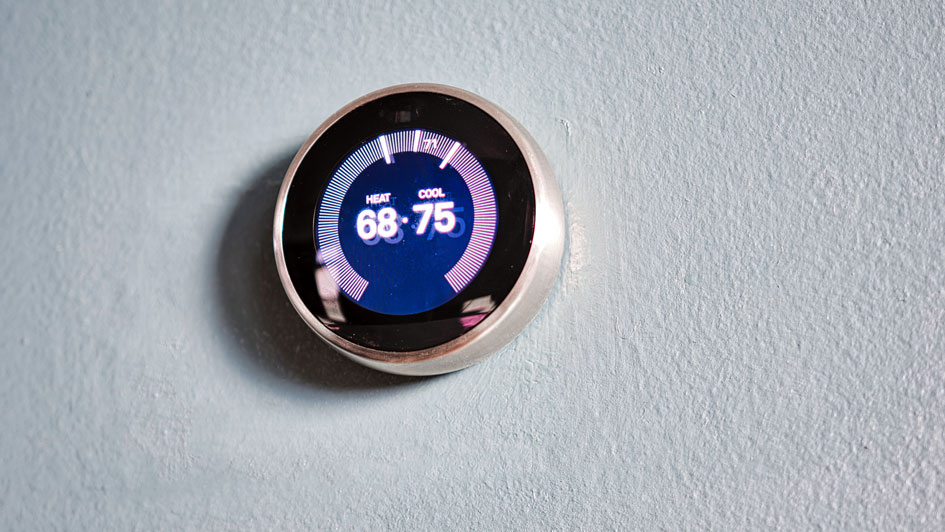
A Nest Thermostat is an excellent tool for keeping your home comfortable, no matter what the season or weather. With features designed around maximizing efficiency, convenience and comfort, a Nest Thermostat is an easy way to manage your energy use — saving you money in the process.
That’s why more homeowners are considering adding devices like a Nest to their homes. If you want to put in a Nest for your own home, reach out to an expert for smart thermostat installation in Bloomfield.
From auto scheduling to energy efficiency monitoring, Nest makes home climate control effortless.
Ready to learn more? Take a look at 12 things you need to know about your Nest Thermostat.
1. How to Reset a Nest Thermostat
A key piece of information to know about resetting a Google Nest Thermostat is that resetting is different from restarting.
- Restart: A common feature in consumer electronics, including your phone or computer, restarting your Nest Thermostat means a quick off / on cycle. This maintains all your settings and is a step to take if your Nest is frozen or not connecting to Wi-Fi.
- Reset: Conversely, resetting eliminates most if not all of your preferred settings. In most cases, people resort to a reset when they’re moving to a new home and bringing the thermostat with them, or if they are moving out and want to erase all personal info from the Nest before leaving it behind for the next resident.
To initiate a reset, it doesn't hurt to write down current temperature settings so they're still available if you forget or erase them. Next, find Settings -> Equipment and write down the details about your system wires, heating type and safety temperature settings.
After writing down this information, go to Settings, select Reset and press. You will then have five options:
- Restart: Shuts your Nest down before rebooting it with your settings. Another method is to press the outside of the Nest and hold it there until it goes black, and then pull your hand away.
- Schedule: This reset clears any info about your temperature schedule—including for your hot water, if you've connected it to your Nest. By choosing this kind of reset, you’ll be given the chance to plan out a new schedule or wait until the Nest learns your schedule.
- Away: An Away reset gets rid of any programming your Nest has picked up about how often you walk by, so that it can update the temperature on its own.
- Network: By selecting a network reset, it forgets connection logins and your Nest can no longer connect to Wi-Fi. Use this option if you want your Nest to forget your Wi-Fi password.
- All Settings: This reset clears all your personal settings and learning.
2. How to Connect Nest Thermostat to Wi-Fi
A stable internet connection is important to getting the most out of your Nest.
To connect your Nest to the internet:
- Access the Quick View menu. This is done by turning the thermostat's outer ring.
- Locate the Settings icon.
- Choose Network.
- Once your Nest is finished scanning for local networks, locate your Wi-Fi and, if needed, put in your password.
3. Does a Nest Thermostat Have a Battery and How Long Will the Battery Last?
Nest thermostats get the power they need directly from your HVAC system, but they also include a rechargeable lithium-ion battery for backup in case of a power outage. According to Google, Nest's manufacturer, a Nest Thermostat battery should last several months. It can be recharged using a USB charger that comes with the Nest.
4. How to Turn Off a Nest Thermostat
If you won't be home for a while, you can set your Nest Thermostat to Off mode, though Eco mode is another solid choice. Off mode shuts down all your regular heating and cooling schedules, although the Nest will still use your Safety Temperatures to keep your home from getting especially hot or cold.
To choose Off mode on the thermostat:
- Hold the touch bar until the display reads “Turn Off” before sliding the bar to highlight Turn Off, and then touch the bar to select.
- You can also go to Mode from the main menu and select Off.
Off mode can even be accessed from your Google Home app:
- Select Thermostat from home screen
- Tap Temperature mode
- Select Off
5. Can Alexa Control a Nest Thermostat?
Yes, Amazon's Alexa is compatible with a Nest Thermostat. Alexa voice controls are also available with Nest doorbells and cameras. You can even operate a Nest Thermostat with Google Assistant.
6. Will My Nest Thermostat Work Without Wi-Fi?
In short, yes. Your Nest Thermostat will still be able to adjust the temperatures without Wi-Fi. That being said, being disconnected from Wi-FI means the Nest doesn’t have the ability to use the smart functions that most people enjoy.
7. Are You Able to Lock a Nest Thermostat?
If you’re having a battle over the thermostat in your home between people who like things hot and others who prefer them cold, Nest can help you bring a little order back to your household.
Nest has a locking feature that allows a user to stop any temperature adjustments outside of a preset range. This won't mean you have to make do with just one temperature—a locked Nest still has access to programmed settings—but simply prevents people from changing the settings.
If you want to lock your Nest:
- Select the Settings icon, scroll to the bottom and tap on Lock.
- Enter a 4-digit pin number you can remember, and do so twice.
- To lock your Nest in Heat or Cool mode, define your maximum and minimum temperature range and then press Lock at the bottom of the screen.
For unlocking it, open the settings and choose Unlock. Once you enter your 4-digit pin, the Nest will be unlocked.
8. Adjusting a Nest Thermostat from a Phone
Nest thermostats can be controlled by your Google Home app, which is accessible on your phone or other smart device, including a computer. Other versions of Nest, including the Nest Thermostat E and Nest Learning Thermostat, are also compatible with remote control via the Nest app.
Before you can make adjustments for a Nest on your phone with Google Home or the Nest app, there are a few steps to complete first:
- Download the Google Home app or, with premium Nest models, the Nest app to your phone.
- Plug in your Nest Thermostat.
- Access the Google Home app on your phone and follow the instructions to select your account, link to your new device and connect to Wi-Fi.
- Google has created a more comprehensive setup guide, if you prefer additional assistance in connecting.
Once you’ve added your Nest to your Home app, it's accessible by clicking Thermostat on the home screen. Once you do that, making adjustments is done by dragging your finger along the screen or tapping on a plus or minus sign.
You also can change preset Nest temperatures on the app. From the home screen, select Thermostat before selecting Settings. At this screen, press Temperature Preferences and then Temperature Presets. Current presets for Comfort, Eco and Sleep modes will be displayed. Select one of these options to change the temperature for that preset.
9. Setting a Nest Thermostat Schedule
A Nest allows you to set temperatures schedules either on the device or on the Google Home app. More advanced versions of the Nest, such as the Nest Thermostat E and Nest Learning Thermostat, are also controllable with the Nest app.
The two easiest ways to schedule your Nest are:
- Quick Schedule: The Quick Schedule feature is based on the national average schedule for energy efficiency. As you set the thermostat up, the Google Home app enables you to set the temperature with a schedule. When choosing this option, it displays a preset schedule and allows you to make changes. Once setup is complete, that’s the schedule it will use.
- Temperature Presets: If you prefer other basic preset options, open the Google Home app and select Thermostat. Then, tap Presets and choose Edit. As soon as you're finished making updates, select Done.
To make tweaks or changes to your current schedule, open the Google Home app, select Thermostat and then tap on Schedules. Choose the day of the week where you want to make changes. After the day is selected, tap Add and find the preset you want. Finally, select Time before touching and dragging the numbers to change the time. The changes won't save unless you select Done.
10. How to Set a Temperature Range on a Nest Thermostat
The Nest features an Eco mode ideal for setting custom temperature ranges. A key part of this feature is the Nest's ability to adjust the temperature based on whether it detects you at home or not.
To create a custom temperature range in Eco mode, go to Settings and select Eco. The thermostat's display should list existing “Heat to” and “Cool to” temperature settings. You can select each and make any and all adjustments. When complete, select Done.
11. What Should I Do If My Nest Thermostat Isn't Compatible?
Nest thermostats can be integrated with most heating and cooling systems. Google, Nest's manufacturer, offers a compatibility tool that asks a series of questions about your location and current setup to learn which Nest model is compatible with your system.
If you don't think your Nest is compatible with your system, it’s best to reach out to a professional for smart thermostat installation in Bloomfield. Experienced technicians evaluate your system and, if your Nest is compatible, get it installed and on the road to saving you money in no time.
12. Can I Manually Control My Nest Thermostat?
Nest Thermostats come with many features designed to improve comfort while keeping costs low. However, you have the ability to turn off the smart features if you want to control a Nest manually like a normal thermostat.
Remember, by doing this you're eliminating your temperature schedules and your Nest will work like any other thermostat—it will display the temperature and let you change the temperature, but that’s about it.
You can achieve this by disabling the settings in a series of steps:
- Auto-Schedule: From the main screen, go to Settings and then scroll to Nest Sense. Go to Auto-Schedule, select No and click Done.
- Eco: From the main screen, go to Settings, scroll to Eco. Once in Eco, select Off for both the current Heat to and Cool to temperatures, and select Done.
- Home/Away Assist: From the main screen, go to Settings and select Home/Away Assist. Then, select Stop Using and click Done.
- Reset: Once you’ve turned off the settings, reset your nest. From the main screen, go to Settings and select Reset, highlight Schedule and then select Reset to clear out any saved scheduling data.

